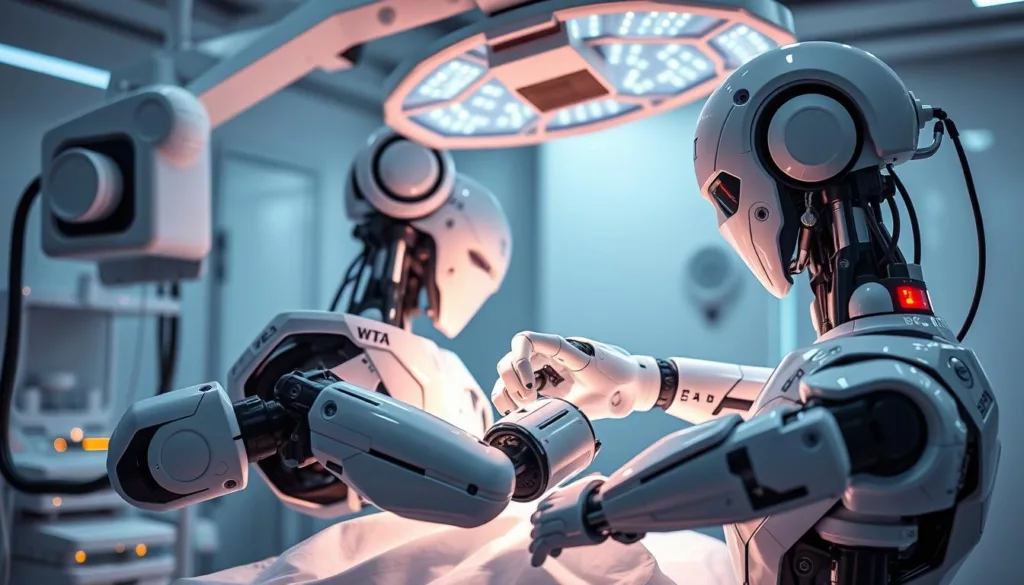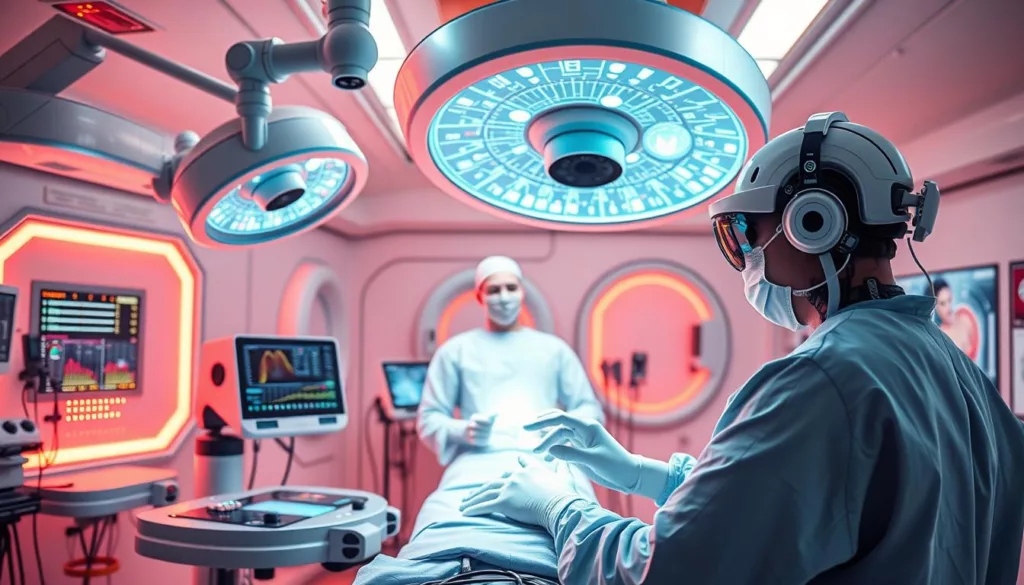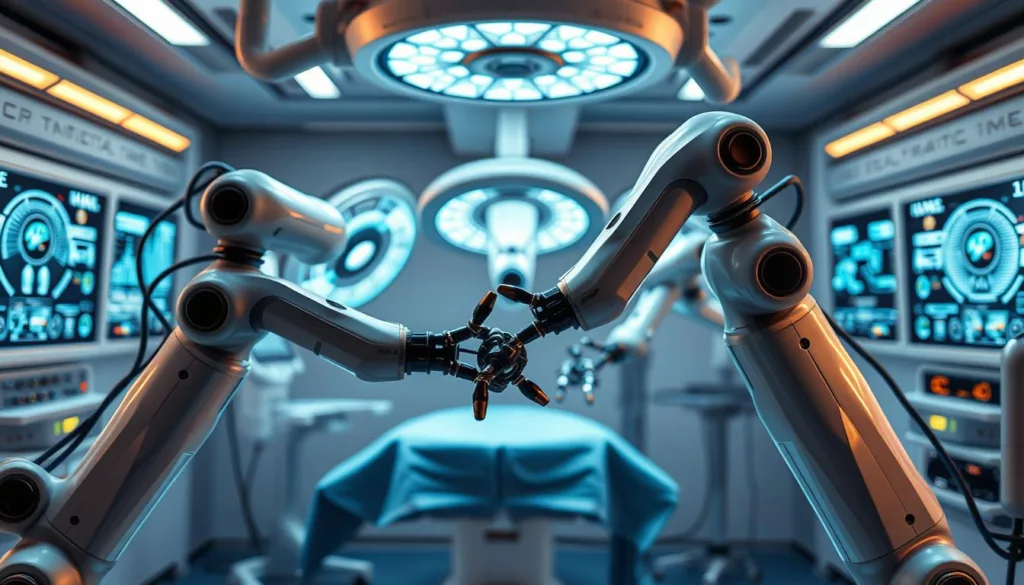Welcome to our deep dive into medical robot sensor solutions for precision surgery. We explore how surgical robotics is changing healthcare. These advanced solutions, like those from XJCSENSOR, are key to better patient care and safer surgeries.
Surgical robotics is a big leap forward. It lets surgeons work with unmatched precision and control. With top-notch sensor tech, doctors can reach new heights in precision surgery. This greatly improves patient results. We’ll show how these innovations are changing surgery and what our solutions mean.
Key Takeaways
- Medical robot sensor solutions enhance the precision of surgical procedures.
- Integration of advanced sensors is vital for improving patient care.
- XJCSENSOR technology supports efficient surgical operations.
- Robotic systems help minimize risks and errors in precision surgery.
- Understanding surgical robotics offers insights into modern healthcare advancements.
Introduction to Medical Robotics
Medical robotics has changed healthcare a lot. It started with simple machines to help surgeons. Now, it’s advanced surgical technology that makes surgeries better and safer.
These robots help doctors work more precisely. They also make surgeries less invasive. This means better care for patients.
Medical robots have made surgeries more efficient. They help doctors do their jobs better. This leads to better results for patients.
As technology gets better, we see more robots in surgery. This means surgeries will be safer and less complicated in the future.
What Are Medical Robot Sensor Solutions?
Medical robot sensor solutions are key in surgical robotics. They use advanced sensors for better precision in surgeries. These systems give surgeons real-time data, making operations safer and more effective.
Benefits of Advanced Sensor Technology
Advanced sensor technology brings many benefits to surgery. Some of these advantages are:
- Increased Precision: Sensors help with precise movements and adjustments.
- Reduced Operation Time: They speed up surgeries by providing quick data.
- Improved Patient Safety: They allow for quick adjustments during surgery.
Types of Sensors Used in Surgical Robotics
Many sensors are important in surgical robotics. Each type has its own role in improving performance. Here are a few:
- Imaging Sensors: They give clear images of the surgical area.
- Haptic Sensors: They let surgeons feel the touch during surgery.
- Force Sensors: They measure force, helping with precise tasks.
Impact of Medical Imaging Sensors on Surgery
Medical imaging sensors are key to better surgery. They give surgeons a clear view of what’s inside the body in real time. This is vital for precise surgeries. With tools like MRI, CT, and ultrasound, surgeons can see exactly where and how things are inside.
Role of Imaging in Surgical Accuracy
These sensors help surgeons make better decisions. They show detailed images of the body’s inner workings. This helps surgeons find important spots and avoid harming vital tissues.
- Increased precision: Better images mean more accurate surgeries.
- Reduced complications: Live images cut down on surgery mistakes.
- Improved patient outcomes: Knowing the body’s layout helps patients heal faster.
Integration with Robotic Systems
Robotic systems are getting better with the help of medical imaging sensors. Together, they make surgeries more precise and safe. The main benefits are:
- Enhanced navigation: Robots use images to guide tools accurately.
- Real-time feedback: Surgeons get updates on the body’s changes during surgery.
- Streamlined workflows: Automation and imaging work together for better efficiency.
The team-up of medical imaging sensors and robotic systems is a big step forward in surgery. It boosts both the accuracy and success of surgeries.
Understanding Haptic Feedback Technology
Haptic feedback technology is changing surgery, giving surgeons real touch feelings. This makes surgeries safer and more precise. It also helps in training new surgeons, making them better prepared for real surgeries.
Enhancing Surgeon Precision with Haptics
Haptic technology gives surgeons real-time touch feedback. They can feel resistance and texture in tissues. This makes them more precise in surgeries.
It helps surgeons make better decisions. This keeps patients safe and healthy.
Training and Simulation Applications
Haptic feedback in training lets new surgeons practice without risk. They use simulation technologies to hone their skills. This makes them more confident and skilled for real surgeries.
Machine Vision Systems in Surgical Robotics
Machine vision systems are key in surgical robotics, making surgeries more precise. They analyze visual data and guide robotic movements. This is vital for modern surgeries.
These systems use advanced imaging technology. They let automated devices work on their own. At the same time, they give surgeons important visual information during operations.
The use of automation in surgical robotics is getting better. This leads to better surgical results and higher safety. Surgeons get real-time image processing, helping them make better decisions.
This technology helps surgeons do their jobs more accurately. It lowers the chance of mistakes during surgery.
Here’s a table comparing traditional surgery and surgery with machine vision systems:
| Feature | Traditional Surgical Methods | Machine Vision-Enhanced Surgical Robotics |
|---|---|---|
| Visual Input | Limited to surgeon’s vision | Real-time visual analytics |
| Automation Level | Manual operation | High-level automation |
| Surgical Precision | Variable | Enhanced accuracy and control |
| Outcomes | Moderate | Improved success rates |
| Safety | Higher risk of errors | Minimized errors and increased safety |
As technology gets better, machine vision systems will change surgical robotics. They will work with new surgical tools to shape the future of surgery. For companies looking for new force sensing solutions, checking out XJCSENSOR’s options could help improve their surgical robotics.
Intraoperative Guidance for Surgeons
Intraoperative guidance is key to better surgery. As tech advances, it’s more important for real-time decisions. Surgeons now have lots of info to help them during complex surgeries.
Improving Decision-Making in Real-Time
New sensor tech has changed surgery. With intraoperative guidance, surgeons get vital info right away. This leads to better choices during surgery. The benefits are clear:
- Enhanced visualization of surgical sites
- Accurate tracking of instrument positions
- Real-time data on patient vitals
- Reduction of surgical errors
Case Studies on Intraoperative Technologies
Many case studies highlight the success of intraoperative tech in various surgeries:
| Case Study | Surgical Specialty | Outcome |
|---|---|---|
| Robot-Assisted Prostatectomy | Urology | Improved Recovery Times |
| Augmented Reality in Neurosurgery | Neurosurgery | Increased Surgical Accuracy |
| 3D Imaging in Orthopedics | Orthopedics | Enhanced Surgical Planning |
Surgical Navigation: A New Era in Surgery
Surgical navigation is a big step forward in surgery, using new tech to make surgeries better. It lets surgeons see and work on complex body parts more accurately. This makes surgeries more precise and safe.
These systems help surgeons work with detailed body maps during surgery. They can see the surgery plan in real time. This helps them make better choices during the surgery. It also helps them do the surgery more accurately.
There are a few key things that make surgical navigation systems work well:
- Enhanced Accuracy: Advanced imaging and real-time data help surgeons be more accurate.
- Improved Patient Outcomes: Better planning and execution mean fewer complications and quicker recovery.
- Informed Decision-Making: Surgeons can make quick changes and find the best path during surgery.
Surgical navigation puts us at the leading edge of precise surgery. It changes how we do surgery for the better. With these new technologies, we can give patients the best care possible through precise surgeries.
| Feature | Benefit |
|---|---|
| Real-Time Imaging | Allows for quick changes during surgery. |
| 3D Visualization | Helps understand complex body parts better. |
| Guided Tools | Helps keep the right path and position. |
Benefits of Robotic Instrument Tracking
Robotic instrument tracking is key in today’s surgery rooms. It makes procedures smoother and safer by keeping an eye on things in real-time. It focuses on two main areas: making surgery more efficient and cutting down on mistakes.
Enhancing Surgical Workflow Efficiency
Having a smooth surgical workflow is vital for good patient care. Robotic tracking systems help manage tools better. This lets surgical teams:
- Keep track of tools as they move around.
- Find tools faster, saving time.
- Set up and clean up the OR more efficiently.
This way of tracking makes surgeries run better and faster.
Minimizing Errors with Real-Time Tracking
Real-time tracking brings precision to surgery. It lets teams:
- Know right away if tools are lost or used wrong.
- Adjust quickly with accurate info.
- Stay focused on the surgery, avoiding distractions.
This reduces mistakes, which is super important in surgery. Real-time tracking shows a strong commitment to safety and accuracy.
Patient Safety Monitoring in Robotic Surgery
In robotic surgery, keeping patients safe is a top priority. It’s all about watching over them closely. By using key metrics and new tech, teams can make surgeries better and safer.
Critical Metrics to Observe During Operations
During robotic surgeries, it’s important to watch a few key things. This helps doctors catch problems early. The main things to watch are:
- Vital Signs: Keeping an eye on heart rate, blood pressure, and oxygen levels.
- Fluid Management: Watching how much fluid is in the body to avoid problems.
- Instrument Performance: Checking if the robotic tools are working right.
- Patient Positioning: Making sure the patient is in the right spot to avoid injuries.
Technological Innovations for Patient Safety
New tech plays a big role in keeping patients safe during robotic surgery. It gives doctors the info they need fast. Some cool new things include:
- AI-Driven Analytics: Tools that look at data to spot problems before they happen.
- Enhanced Imaging: Better cameras and images help doctors see more clearly during surgery.
- Automated Alerts: Systems that send alerts if something looks off, so doctors can act fast.
- Telemonitoring: Ways to watch over patients from far away, even when they’re in another room.
| Critical Metric | Importance | Monitoring Technology |
|---|---|---|
| Vital Signs | Early detection of distress | Continuous electronic monitoring |
| Fluid Management | Prevention of imbalances | Automated fluid tracking systems |
| Instrument Performance | Ensures reliability during surgery | Real-time diagnostics |
| Patient Positioning | Avoids possible injuries | Positioning monitoring systems |
Medical Robot Sensor Solutions for Precision Surgery
Medical robotics is growing fast, and precision sensors are key to better surgery. Our advanced sensors make surgeries safer and more effective. They help surgeons get the exact data they need right away.
Key Features of Precision Sensor Solutions
Our precision sensors have important features for better surgery:
- Accuracy: Our sensors give precise measurements, helping surgeons do detailed work confidently.
- Real-Time Feedback: They send data quickly, helping surgeons make fast decisions during tough surgeries.
- Seamless Integration: These sensors work well with different surgical systems, making operations smooth.
Future Directions in Medical Robotics
The future of medical robotics looks bright with new advancements:
- AI Integration: Adding artificial intelligence can help make better decisions and predict surgical needs.
- Enhanced Imaging Systems: New imaging tech will make surgeries even more accurate.
- Collaborative Approaches: Working together will bring new ideas and lower costs, improving patient care.
Want to see how precision sensors are changing surgery? Check out XJCSENSOR’s medical applications page.
Collaborations in the Surgical Robotics Field
In the world of surgical robotics, teamwork is key to innovation. The mix of tech companies, hospitals, and research groups has led to big steps forward. These steps make surgeries better and safer.
Through surgical robotics collaborations, new tech is born. Partners share skills, knowledge, and resources. This teamwork leads to more efficient and dependable robots. Together, they tackle tough problems and explore new medical tech areas.
- Enhanced Product Development: Joint efforts lead to innovative solutions.
- Integration of New Technologies: Seamless adoption of advancements into clinical practice.
- Research and Development: Combined expertise accelerates the R&D process.
- Improved Patient Care: Collaboration ultimately focuses on better outcomes for patients.
These partnerships push tech forward and give doctors the best tools. Strong industry partnerships support the healthcare world’s needs. They open doors to more surgical robotics breakthroughs.
Innovations from XJCSENSOR
XJCSENSOR is at the forefront of advanced sensor technologies. These technologies greatly impact surgical practices. Our goal is to improve surgical precision and patient outcomes.
Overview of XJCSENSOR’s Technology
Our technology overview shows our advanced sensors for precision surgery. These sensors improve communication between surgical tools and robots. This ensures smooth integration.
Our products give surgeons real-time feedback. This allows them to do complex surgeries with high accuracy.
Case Studies on XJCSENSOR Solutions
Our technologies have led to successful surgeries in many settings. We share several case studies that highlight our sensors’ effectiveness. Each study shows how our solutions boost surgical performance and patient safety.
| Case Study | Application | Outcome |
|---|---|---|
| Robotic-assisted Surgery | Integration with existing surgical robots | Increased precision and reduced recovery time |
| Haptic Feedback Systems | Enhancing surgeon sensitivity during operation | Improved dexterity and skill application |
| Real-time Monitoring | Patient vital signs during surgery | Immediate response to patient needs |
Conclusion
Advanced sensor technology is changing surgery for the better. It makes operations more precise and efficient. At XJCSENSOR, we focus on creating top-notch, customizable sensors for healthcare.
Looking ahead, we aim to keep improving surgical robots. We work closely with doctors to solve real problems. Our goal is to make medical procedures safer and more effective.
At the heart of medical robotics are precision sensors. They give surgeons the tools for outstanding results. We’re leading the way in innovation, ready to improve patient care. Learn more about our robotic sensors at XJCSENSOR’s solutions.





